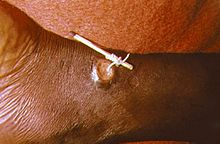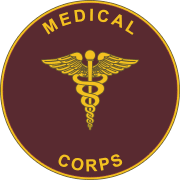Rod of Asclepius
from wikipedia.org
 In Greek mythology, the Rod of Asclepius (Greek: Rįbdos tou Asklipioś, sometimes also spelled Asklepios), also known as the Staff of Aesculapius and as the asklepian, is a serpent-entwined rod wielded by the Greek god Asclepius, a deity associated with healing and medicine. The symbol has continued to be used in modern times, where it is associated with medicine and health care, yet frequently confused with the staff of the god Hermes, the caduceus. Theories have been proposed about the Greek origin of the symbol and its implications.
Greek mythology and Greek society
In Greek mythology, the Rod of Asclepius (Greek: Rįbdos tou Asklipioś, sometimes also spelled Asklepios), also known as the Staff of Aesculapius and as the asklepian, is a serpent-entwined rod wielded by the Greek god Asclepius, a deity associated with healing and medicine. The symbol has continued to be used in modern times, where it is associated with medicine and health care, yet frequently confused with the staff of the god Hermes, the caduceus. Theories have been proposed about the Greek origin of the symbol and its implications.
Greek mythology and Greek society
The Rod of Asclepius takes its name from the Greek god Asclepius, a deity associated with healing and medicinal arts in Greek mythology. Asclepius' attributes, the snake and the staff, sometimes depicted separately in antiquity, are combined in this symbol. The most famous temple of Asclepius was at Epidaurus in north-eastern Peloponnese. Another famous healing temple (or asclepeion) was located on the island of Kos, where Hippocrates, the legendary "father of medicine", may have begun his career. Other asclepieia were situated in Trikala, Gortys (Arcadia), and Pergamum in Asia. In honor of Asclepius, a particular type of non-venomous snake was often used in healing rituals, and these snakes – the Aesculapian snakes – crawled around freely on the floor in dormitories where the sick and injured slept. These snakes were introduced at the founding of each new temple of Asclepius throughout the classical world. From about 300 BCE onwards, the cult of Asclepius grew very popular and pilgrims flocked to his healing temples (Asclepieia) to be cured of their ills. Ritual purification would be followed by offerings or sacrifices to the god (according to means), and the supplicant would then spend the night in the holiest part of the sanctuary – the abaton (or adyton). Any dreams or visions would be reported to a priest who would prescribe the appropriate therapy by a process of interpretation. Some healing temples also used sacred dogs to lick the wounds of sick petitioners. The original Hippocratic Oath began with the invocation "I swear by Apollo the Healer and by Asclepius and by Hygieia and Panacea and by all the gods ..." The serpent and the staff appear to have been separate symbols that were combined at some point in the development of the Asclepian cult. The significance of the serpent has been interpreted in many ways; sometimes the shedding of skin and renewal is emphasized as symbolizing rejuvenation, while other assessments center on the serpent as a symbol that unites and expresses the dual nature of the work of the Apothecary Physician, who deals with life and death, sickness and health. The ambiguity of the serpent as a symbol, and the contradictions it is thought to represent, reflect the ambiguity of the use of drugs, which can help or harm, as reflected in the meaning of the term pharmakon, which meant "drug", "medicine", and "poison" in ancient Greek. However the word may become less ambiguous when "medicine" is understood as something that heals the one taking it because it poisons that which afflicts it, meaning medicine is designed to kill or drive away something and any healing happens as a result of that thing being gone, not as a direct effect of "medicine". Products deriving from the bodies of snakes were known to have medicinal properties in ancient times, and in ancient Greece, at least some were aware that snake venom that might be fatal if it entered the bloodstream could often be imbibed. Snake venom appears to have been 'prescribed' in some cases as a form of therapy. The staff has also been variously interpreted. One view is that it, like the serpent, "conveyed notions of resurrection and healing", while another (not necessarily incompatible) is that the staff was a walking stick associated with itinerant physicians. Cornutus, a Greek philosopher probably active in the first century CE, in the Theologiae Graecae Compendium (Ch. 33) offers a view of the significance of both snake and staff:
Asclepius derived his name from healing soothingly and from deferring the withering that comes with death. For this reason, therefore, they give him a serpent as an attribute, indicating that those who avail themselves of medical science undergo a process similar to the serpent in that they, as it were, grow young again after illnesses and slough off old age; also because the serpent is a sign of attention, much of which is required in medical treatments. The staff also seems to be a symbol of some similar thing. For by means of this it is set before our minds that unless we are supported by such inventions as these, in so far as falling continually into sickness is concerned, stumbling along we would fall even sooner than necessary.In any case, the two symbols certainly merged in antiquity as representations of the snake coiled about the staff are common. It has been claimed that the snake wrapped around the staff was a species of rat snake, Elaphe longissima, the Aesculapian snake. Theories
 |

|
|
|
As god of the high-road and the market-place Hermes was perhaps above all else the patron of commerce and the fat purse: as a corollary, he was the special protector of the traveling salesman. As spokesman for the gods, he not only brought peace on earth (occasionally even the peace of death), but his silver-tongued eloquence could always make the worse appear the better cause. From this latter point of view, would not his symbol be suitable for certain Congressmen, all medical quacks, book agents and purveyors of vacuum cleaners, rather than for the straight-thinking, straight-speaking therapeutist? As conductor of the dead to their subterranean abode, his emblem would seem more appropriate on a hearse than on a physician's car.
— "The Caduceus", in The Scientific Monthly in 1932, in Stuart L. Tyson